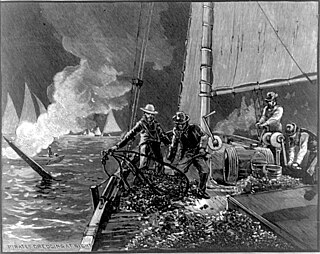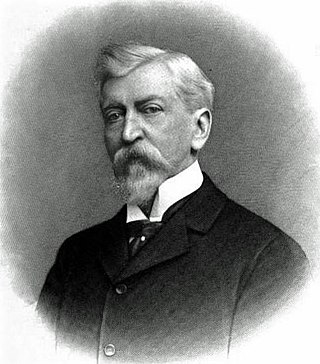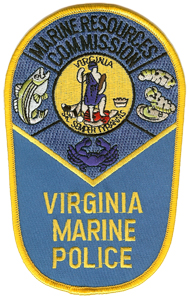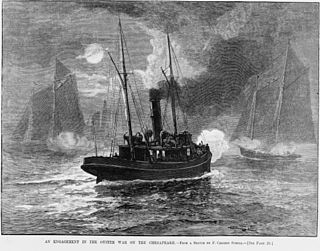
Edward Teach, better known as Blackbeard, was an English pirate who operated around the West Indies and the eastern coast of Britain's North American colonies. Little is known about his early life, but he may have been a sailor on privateer ships during Queen Anne's War before he settled on the Bahamian island of New Providence, a base for Captain Benjamin Hornigold, whose crew Teach joined around 1716. Hornigold placed him in command of a sloop that he had captured, and the two engaged in numerous acts of piracy. Their numbers were boosted by the addition to their fleet of two more ships, one of which was commanded by Stede Bonnet, but Hornigold retired from piracy toward the end of 1717, taking two vessels with him.

The Chesapeake Bay is the largest estuary in the United States. The bay is located in the Mid-Atlantic region and is primarily separated from the Atlantic Ocean by the Delmarva Peninsula, including parts of the Eastern Shore of Maryland, the Eastern Shore of Virginia, and the state of Delaware. The mouth of the bay at its southern point is located between Cape Henry and Cape Charles. With its northern portion in Maryland and the southern part in Virginia, the Chesapeake Bay is a very important feature for the ecology and economy of those two states, as well as others surrounding within its watershed. More than 150 major rivers and streams flow into the bay's 64,299-square-mile (166,534 km2) drainage basin, which covers parts of six states and all of Washington, D.C.

An oyster pirate is a person who poaches oysters. It was a term that became popular on both the West Coast of the United States and the East Coast of the United States during the 19th century.

The Eastern Shore of Maryland is a part of the U.S. state of Maryland that lies mostly on the east side of the Chesapeake Bay. Nine counties are normally included in the region. The Eastern Shore is part of the larger Delmarva Peninsula that Maryland shares with Delaware and Virginia.

William Evelyn Cameron was a Confederate soldier who became a Virginia lawyer, journalist, and politician. He served as the 39th Governor of Virginia from 1882–1886, elected as the candidate of the Readjuster Party headed by William Mahone.

USS Stars and Stripes was a 407-ton steamer acquired by the U.S. Navy and put to use by the Union during the American Civil War.

The first USS Pocahontas, a screw steamer built at Medford, Massachusetts in 1852 as City of Boston, and purchased by the Navy at Boston, Massachusetts on 20 March 1855, was the first United States Navy ship to be named for Pocahontas, the Algonquian wife of Virginia colonist John Rolfe. She was originally commissioned as USS Despatch – the second U.S. Navy ship of that name – on 17 January 1856, with Lieutenant T. M. Crossan in command, and was recommissioned and renamed in 1860, seeing action in the American Civil War. As Pocahontas, one of her junior officers was Alfred Thayer Mahan, who would later achieve international fame as a military writer and theorist of naval power.

USSWhitehead, a screw steamer built in 1861 at New Brunswick, New Jersey, served as a gunboat in the United States Navy during the American Civil War.

The Lynnhaven River is a tidal estuary located in the independent city of Virginia Beach, Virginia, in the United States, and flows into the Chesapeake Bay west of Cape Henry at Lynnhaven Inlet, beyond which is Lynnhaven Roads. It has a small, developed watershed covering 64 square miles (170 km2), terminating at Lynnhaven Bay. It was once famous along the East Coast of the United States for its oysters, which declined through pollution and runoff. It is now being restored by the Lynnhaven River Now restoration project based out of the Brock Environmental Center. A proposed comprehensive project for ecosystem restoration of the Lynnhaven River Basin is currently under consideration by the United States Congress.
Israel Hands, also known as Basilica Hands, was an 18th-century pirate best known for being second in command to Edward Teach, better known as Blackbeard. His name serves as the basis for the name of the villainous sidekick in Robert Louis Stevenson's 1883 novel Treasure Island.
USS John L. Lockwood was a steamer acquired by the Union Navy during the American Civil War. She was needed by the Navy to be part of the fleet of ships to prevent blockade runners from entering ports in the Confederacy.

The Virginia Marine Police is the law enforcement division of the Virginia Marine Resources Commission, an agency of the Commonwealth of Virginia, United States.
The third USS Union was a heavy (1,114-ton) steamer with a powerful 12-inch rifled gun purchased by the United States Navy during the American Civil War.

The Baltimore Steam Packet Company, nicknamed the Old Bay Line, was an American steamship line from 1840 to 1962 that provided overnight steamboat service on Chesapeake Bay, primarily between Baltimore, Maryland, and Norfolk, Virginia. Called a "packet" for the mail packets carried on government mail contracts, the term in the 19th century came to mean a steamer line operating on a regular, fixed daily schedule between two or more cities. When it closed in 1962 after 122 years of existence, it was the last surviving overnight steamship passenger service in the United States.
Frolic was a Maryland State Oyster Police Force schooner, part of the force established to enforce state conservation laws designed to protect Maryland's oyster resources when out of state, often New England, dredgers began destroying reefs in the Chesapeake Bay. Later local opposition to licenses turned to open "warfare" in the "oyster wars" when a fleet of state vessels fought "oyster pirates" in armed conflicts. Frolic was built in 1884. The schooner was assigned to Queen Anne's County, Maryland in 1902 and later to the Commission's Second District which included Eastern Bay, and the Miles and Wye Rivers.

Governor R. M. McLane, was a steamboat built in 1884 that served the state of Maryland as an enforcement and survey vessel.
The Battle of Cockle Creek, October 5, 1861, was a minor naval engagement off Chincoteague, Virginia early in the American Civil War.

The Oyster Wars were a series of sometimes violent disputes between oyster pirates and authorities and legal watermen from Maryland and Virginia in the waters of the Chesapeake Bay and the Potomac River from 1865 until about 1959.

Julia Hamilton was a Maryland State Oyster Police Force schooner, part of the force established to enforce state conservation laws designed to protect Maryland's oyster resources when out of state, often New England, dredgers began destroying reefs in the Chesapeake Bay. Later local opposition to licenses turned to open "warfare" in the "oyster wars" when a fleet of state vessels fought "oyster pirates" in armed conflicts.
Giller is a 19th-century term for a person who fishes using a gillnet, as used in the Chesapeake Bay region from the early 19th to the mid-20th centuries. Gillers worked individually or in groups of two or three men using a small boat from which they set and gathered a gillnet. Gillnets first appeared on the Potomac River in 1838 to fish for American shad, and rapidly became the most popular type of fishing gear in the bay region because they allowed the independent fisherman to work with limited resources, following the fish with his boat and net as they moved from place to place in search of food or to spawn. Gillnet fishing in Chesapeake Bay shad fisheries frequently led to conflict among states bordering the bay, with Pennsylvania seiners blaming Maryland gillers for over-harvesting and blocking shad passage upstream into the Susquehanna River, and Maryland gillers blaming Virginia pound-netters for intercepting fish on their northward migration up the bay. Conflicts sometimes erupted into violent confrontations, called "Gillers Wars," during one of which in 1876, a giller in Charles County, Maryland was indicted by the county court for assault with intent to kill the captains of a steamer and a tug. Upon trial he was found not guilty, but his case evidences the extent of the trouble between gillnetters and other bay users that led to involvement by state authorities in regulating fishing and settling disputes involving gillers.















